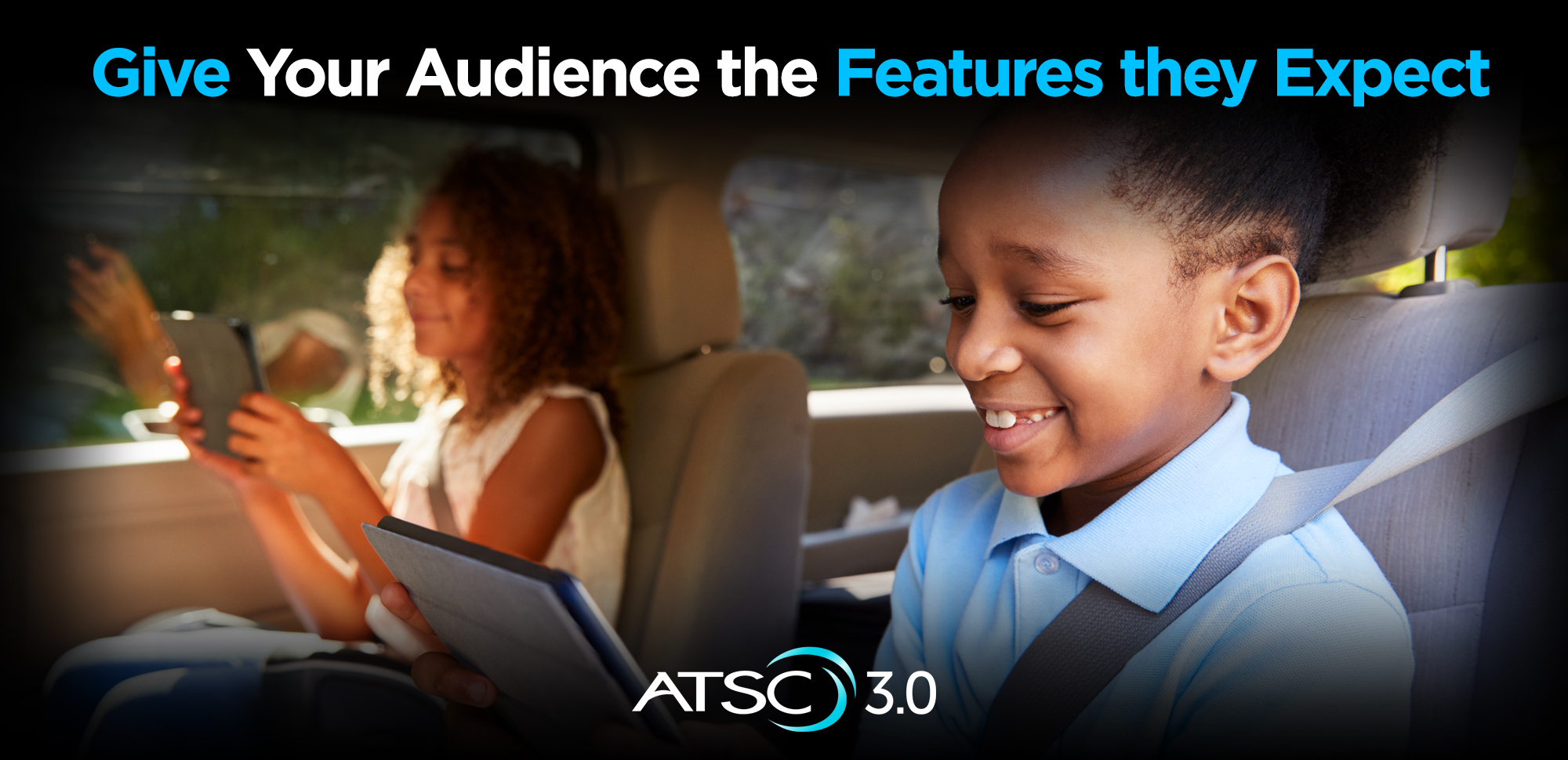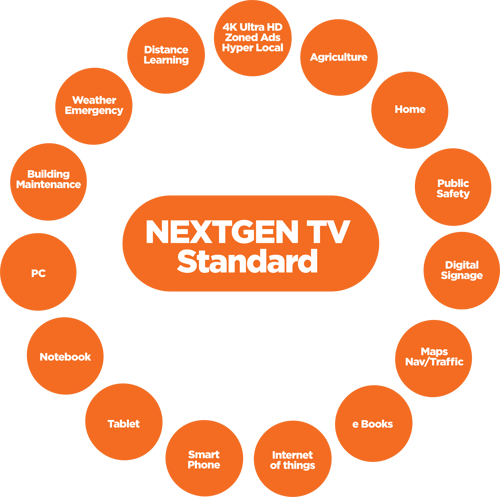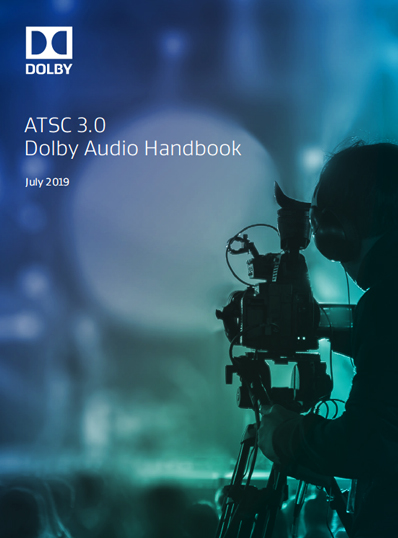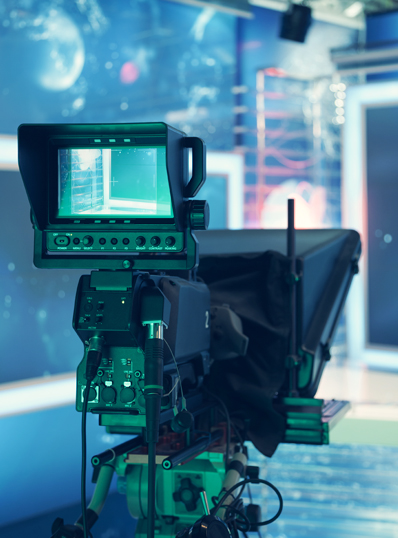
What Is ATSC 3.0 / NEXTGEN TV?
According to the Advanced Television Systems Committee, ATSC 3.0 (used interchangeably with “NETGEN TV”) is the next-generation terrestrial broadcasting system specifically designed to improve the TV viewing experience with higher audio and video quality ( 4k resolution ), better compression efficiency, robust transmission for reception on both fixed and mobile devices, and more accessibility, personalization, and interactivity. The standard is defined in a suite of more than 20 Standards and companion Recommended Practices!
ATSC 3.0 / NEXTGEN TV Benefits
- • IP-based backbone
- • Brings together Over-the-Air & Over-the-Top content
- • Better video quality
- • Better quality, immersive audio
- • Dialogue enhancement and consistent audio levels
- • Capability of Advanced Emergency Alerting and Informing
- • Adaptable for future technologies
- • Watermarking across platforms
It’s Built on Internet Protocol
With this new broadcasting standard, for the first time ever, the broadcast platform is built on the same Internet Protocol backbone as today’s popular streaming media platforms, allowing broadcasters to break free from the box and push broadcast to mobile, cars, gaming consoles...anywhere. ATSC 3.0 / NEXTGEN TV also allows broadcast to play by Internet rules, giving your audience choice and an overall enhanced experience that they have now come to expect from your competitors. Consumers want to enjoy their content on the move, demanding personalization and choice.
Over-the-Air & Over-the-Top Come Together
NEXTGEN TV is designed to bring together Over-the-Air with Over-the-Top content, enabling broadcasters to keep pace with digital platforms that already offer many of the features and benefits of ATSC 3.0, such as immersive audio and customized audio content like offering much more flexible language options and the ability to access different commentators during sporting events.
Incredible Video
NEXTGEN TV delivers a new and more engaging experience to viewers, including video content with higher resolutions (4k UHD) and greater dynamic range (HDR). It delivers stunning video with brilliant color, sharper images and deeper contrast.
Watermarking: The Key to ATSC 3.0 Success
Watermarking is the key to NEXTGEN TV’s success. It protects broadcasters’ content and gives audience measurements across all platforms where consumers consume content, including streaming!
Immersive Audio
While the benefits are easy to see, the promise of a better experience can only be fully realized by engaging the audiences’ eyes AND ears. The standard is filled with exciting new aural features like immersive audio. Immersive Audio (presented as Dolby® Atmos here in America) adds additional channels overhead and creates an enveloping audible experience for the listener, making them feel like they’ve been pulled into the action.
This immersive experience is delivered to audience's ears by way of complete Atmos surround sound speaker systems, soundbars, upfiring speakers, standard headphones, and even specialized headphones designed for immersive sound! Sure, you can get an immersive experience in some post-produced shows, but we’re still in the relatively early stages of live programs and events including immersive programming on a regular basis using Dolby Digital Plus™. NBC delivered 4K UHD with Dolby Atmos sound for the 2022 Winter Olympics coverage to customers through distribution partners including Comcast, Verizon, fuboTV, YouTubeTV, and Prime. Immersive Audio is one of the leading features for this new standard.
The Power of Personalized Audio
Personalization with ATSC 3.0 is a big deal. Because you we now using “object-based” immersive surround, viewers can choose to raise or lower the volume of a particular object to their fancy.
For example, ATSC-3.0-capable receivers can mix together elements of the live audio to create a “bed mix” of music and effects (M&E) along with the individual dialog channels and have the receiver mix the user-selected dialog and the M&E bed into the final presentation that the listener hears, providing a much better experience for viewers that’s tailored to their own preferences. Receiver mixing also allows viewers who select an alternate language track or who require a descriptive audio track to receive the program in full surround or immersive, making the new standard much more accessible.
Enhanced Dialog
The spoken word remains at the heart of television audio but can sometimes be difficult to hear in an immersive mix. The audio codec used in ATSC 3.0 (Dolby AC-4 or MPEG-H from Fraunhofer) also includes technology to enhance the dialogue. Making it easier for the Hearing Impaired or for those watching late at night with family members asleep in the house and low volume, to understand the program.
Consistent Audio Levels
No more excessive volume changes when switching between channels and shows. NEXTGEN TV offers you a pleasant, uniform sound experience.
TElos Alliance ATSC 3.0 SolutionS
Only Telos Alliance has the tools you need to transition to this latest standard in audio broadcasting, fast.
Linear Acoustic LA-5300 Broadcast Audio Processor
NEXTGEN TV/ATSC 3.0
Get on the air quickly with everything you need for your services. LA-5300 includes upmixing, loudness control, audience measurement watermarking, monitoring, and the transmission of Dolby Atmos content through Dolby AC-4 encoding. It can accept a Dolby Digital input from an ATSC 1 service and transcode that directly into Dolby AC-4, or encode Dolby AC-4 directly from PCM. It is fully capable of inserting watermarking into the audio stream and upmixing content to provide a consistent soundfield output. Learn more.
Linear Acoustic UPMAX ISC Immersive Soundfield Controller
NEXTGEN TV/ATSC 3.0 IMMERSIVE
Upmixing is a useful tool to get an immersive audio service on the air quickly and easily while you are planning on your “true” immersive workflow. The Telos Alliance Linear Acoustic UPMAX ISC Immersive Soundfield Controller provides upmixing from stereo or surround to immersive. It can also be configured to upmix stereo to 5.1. stereo or legacy surround formats to immersive in preparation for encoding by any codec supporting immersive audio, including Dolby Digital Plus™ JOC or Dolby AC-4 and MPEG-H for NEXTGEN TV transmission.
Minnetonka AudioTools
Server
NEXTGEN TV/ATSC 3.0 IMMERSIVE
AudioTools Server automates the most sophisticated audio tasks and offers a wide variety of processing, specifically created for use in cable, satellite, OTT, terrestrial and IPTV, radio, and post-production facilities.
AudioTools Server handles NEXTGEN TV audio workflows by handling ATSC 3.0 in the File-Based Domain. It's your complete Atmos toolkit for file-based workflow orchestration, including Linear Acoustic ISC for upmixing stereo or legacy surround formats to immersive audio, Dolby Digital Plus JOC encoding, and MPEG-H encoding for NEXTGEN TV applications.
ATSC 3.0: Broadcast + Broadband & EAS

ATSC 3.0 Resources
Dolby Audio Handbook
This handbook provides broadcasters in North America with the documentation, support, and resources required to move from AC-3 to AC-4 audio in the transition from ATSC 1.0 to ATSC 3.0, with a specific focus on the practical and technical considerations integrating AC-4 into ATSC 3.0 workflows.An In-Depth Conversation with Madeleine Nolan, President of ATSC
Telos Alliance's Marty Sacks chats with president of the Advanced Television Systems Committee, Madeleine Noland, to speak about the new standard, as well as all of the opportunities, content capabilities, and challenges that come along with it. Read the blog.
Blog: Making Sense of the Next Generation of TV Audio
The emergence of immersive audio and the deployment of ATSC 3.0 has introduced an entirely new television audio lexicon. Here, we help untangle the ball of TV audio twine.





